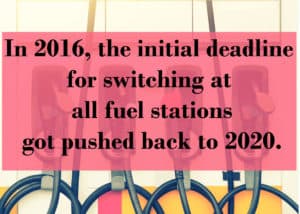This month, we’ve focused a lot on the current security issues affecting the payments industry. From user failure when it comes to online best practices to the rise in headline-grabbing data breaches, payments security has never been a more relevant and crucial issue than it is now.
One critical security issue is the slow rate of EMV-chip reader adoption in America. While EMV chip-and-pin cards have been the standard in Europe for years, America is still struggling to fully switch. We’ve talked before about why EMV is more secure than the traditional swipe-and-sign method. Today we’re exploring one market that has been the slowest to switch, and the consequences of that delay.

EMV at Gas Stations
The shift to EMV at gas stations has been slow at best. Gas stations are the one industry that have largely put off switching altogether. Gas stations’ EMV adoption has been so slow that Visa extended the deadline for switching. The initial 2017 deadline for switching at all fuel stations got pushed back to 2020 in December of 2016.
The reason?
 EMV at gas stations is a more complicated and expensive endeavor than in other industries. Most gas stations do offer EMV-readers at their in-store POS systems. However few have made the switch at the pumps themselves. This is because the cost and actual installation of the terminals is extremely problematic.
EMV at gas stations is a more complicated and expensive endeavor than in other industries. Most gas stations do offer EMV-readers at their in-store POS systems. However few have made the switch at the pumps themselves. This is because the cost and actual installation of the terminals is extremely problematic.
Gray Taylor, executive director of Connexus, told CardConnect that about one third of the 750,000 pump dispensers in use are too old and would need to be replaced in order to accept chip cards. The average price for a replacement is $17,000. And that’s not including the price of new hardware and software needed to support EMV.
Further complicating the issue are the federal regulation guidelines that govern gas station fuel pumps. Federal guidelines require a technician to perform a safety check whenever a gas station replaces a fuel-dispenser. The technicians licensed to perform these checks are few and far between and tend to give priority to large retailers over small stores.
The Result: Skimming Galore
This combination of issues makes the switch to EMV at gas stations a particularly complicated process. As a result, few have moved to EMV, which means that gas stations are widely known as the last wide-open industry for card vulnerability exploitation.
 Card skimming is an increasingly alarming problem at gas stations. A recent report by Krebs on Security details some of the different methods being used today to skim at fuel pumps to swipe consumer data. All of them rely on the same key factor: outdated POS systems that aren’t EMV enabled are easy to manipulate.
Card skimming is an increasingly alarming problem at gas stations. A recent report by Krebs on Security details some of the different methods being used today to skim at fuel pumps to swipe consumer data. All of them rely on the same key factor: outdated POS systems that aren’t EMV enabled are easy to manipulate.
Bottom Line
The shift to EMV-chip readers has been a critical step in the payments industry across all markets in better protecting both companies and their customers from fraud. As gas stations become the last industry to make the switch, the need for EMV is increasingly clear as the amount of fraud at gas stations continues to rise.
So what can you do? We’ve talked before about why it’s important to have and use a credit card instead of a debit card for purchases like this. Using your credit card gives you better protection in general, which is crucial at places that your odds of breach are higher.
Another key takeaway? Switching to EMV terminals is vital to your payments security. So if your business has delayed making the switch, it’s time to make it happen. Luckily, at Pineapple we offer the best technology in the business at amazing rates. Our team works tirelessly to ensure you’re protected and processing quickly, effectively, and securely from day one. Contact us today!

